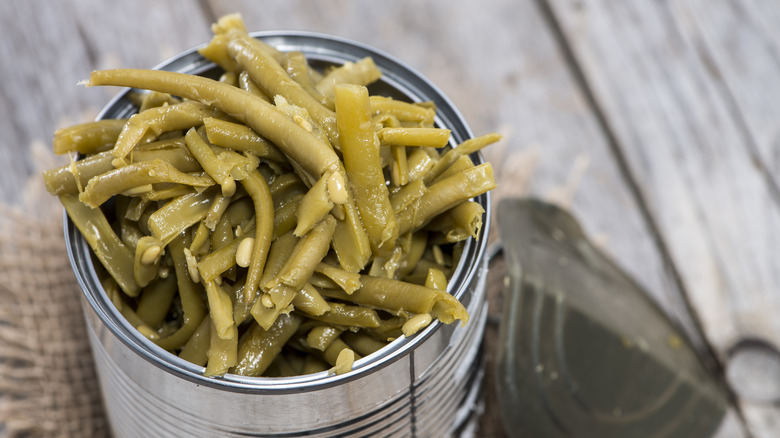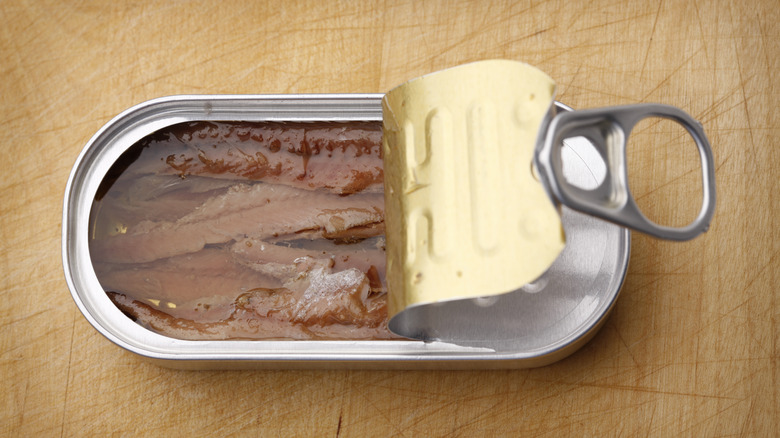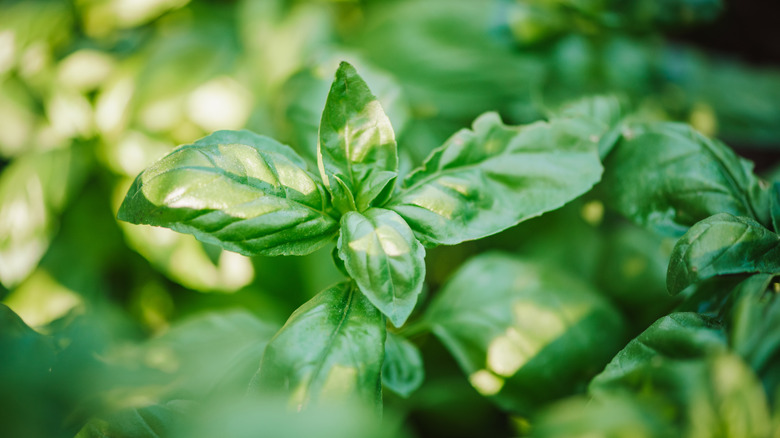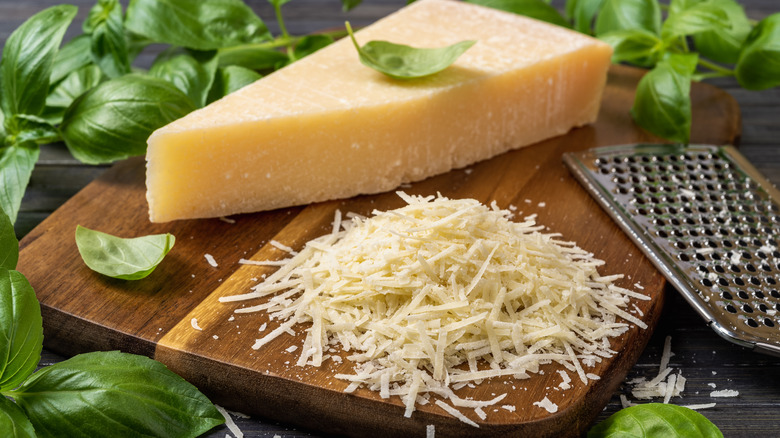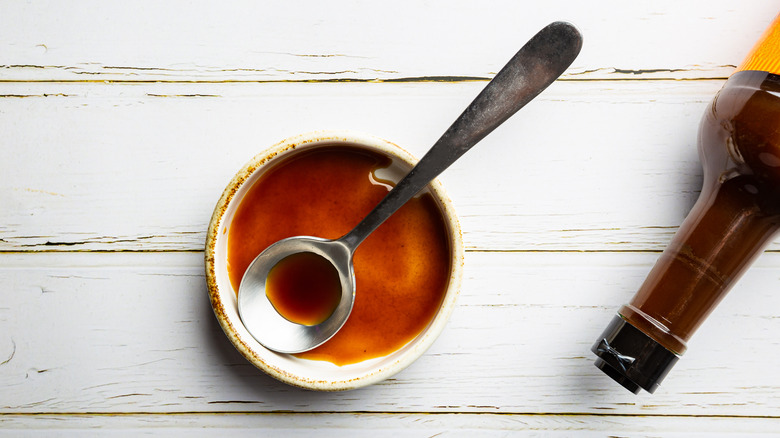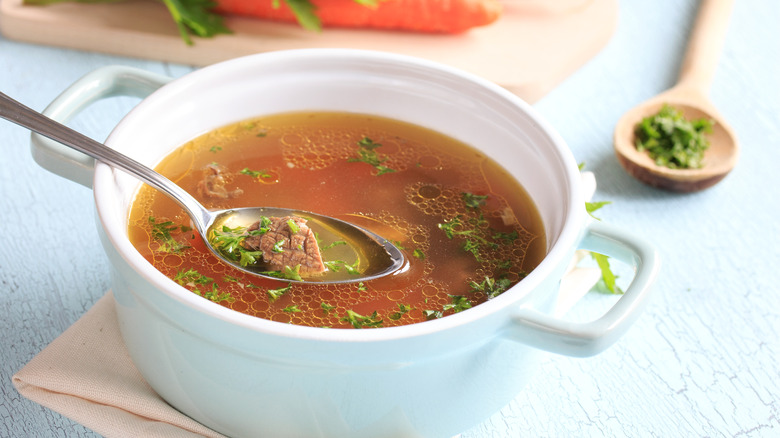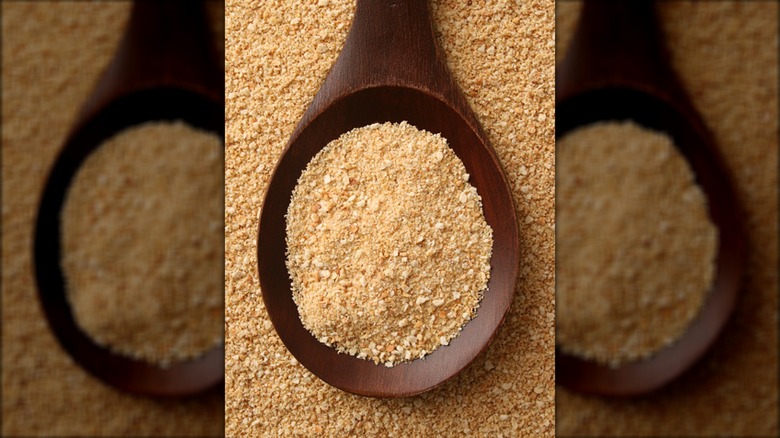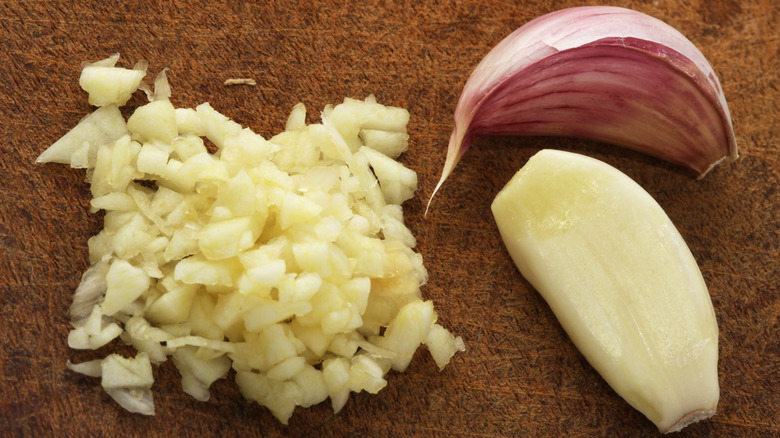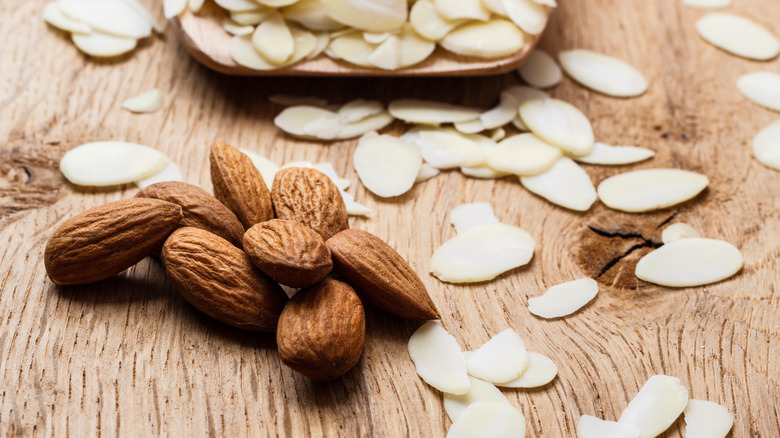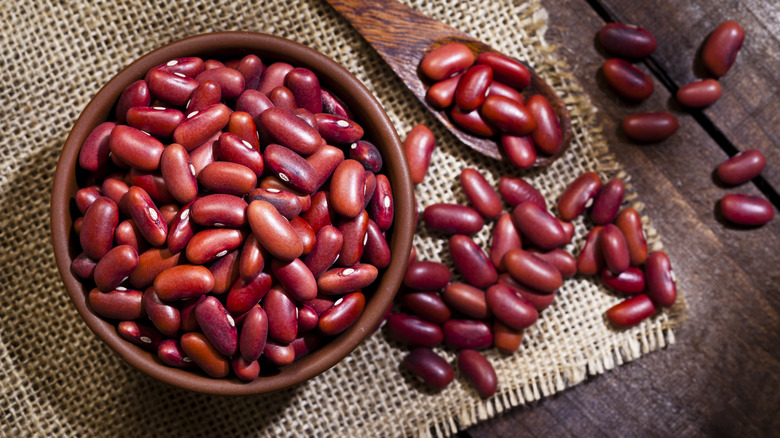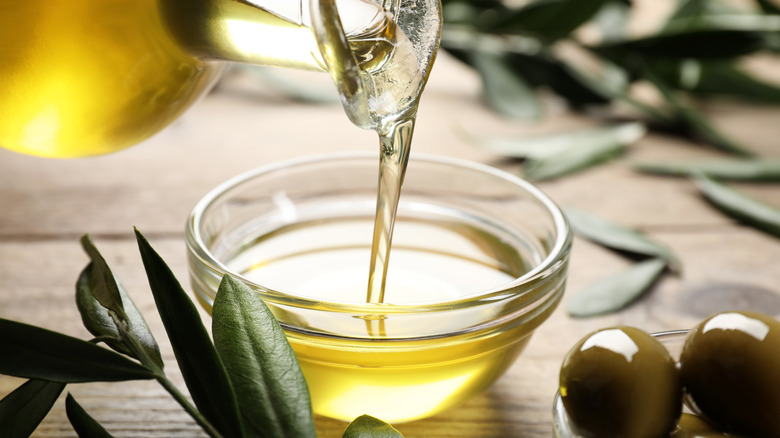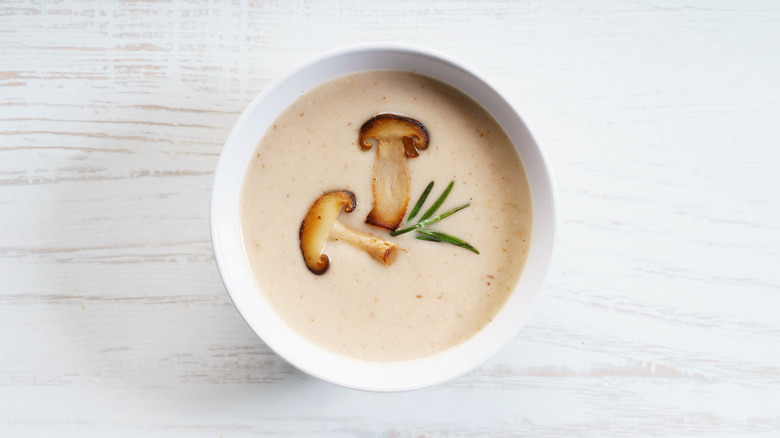14 Ingredients That Will Seriously Upgrade Canned Green Beans
It can seem daunting to think about trying to upgrade canned vegetables, and canned green beans are no exception. Given that they're already cooked, they can feel somewhat less versatile than fresh green beans and less capable of taking on new flavors. However, that's far from the case. Canned green beans can be upgraded with a multitude of different ingredients, and all of them help improve their mellow, lightly sweet taste and tender, yet soft texture.
Some of these ingredients can boost your green beans in innovative ways. Many unlock hidden depths in your beans by boosting their umami content and helping to bolster their natural earthiness. Others can give these canned vegetables some much-needed crunch, which often gets lost during the preserving process, and make them more appealing texture-wise. Plus, canned green beans are often overly salty, and adding ingredients to them can help to temper the brininess, giving important flavor contrasts that help to balance the taste. The best part is that a lot of these ingredients are ones you already have in your home or are readily available from the store. Let's check out a few of our favorites.
1. Anchovies
Ah, good old anchovies. These small fish are perfect for adding richness and saltiness to pretty much everything, making them a favorite in countless recipes. Here, though, they're an unexpected ingredient that adds loads of flavor to green beans. The reason they work so well with green beans is because of the vegetable's relatively mild flavor, which sort of gets unlocked in this combo. When paired with anchovies, the beans let the fish stand front and center, and yet somehow, their sweetness seems to intensify.
Pairing these ingredients is surprisingly simple, too. Our favorite way to do it is to fry some anchovies in a little olive oil to help bolster their flavor while also breaking them down. When you fry them, canned anchovies turn soft and almost disappear, becoming a kind of oily anchovy dressing. Then, pour your drained green beans into the pan. It can be a good idea to pat them dry before doing this so that they don't add any excess moisture to the mixture. Toss them together, dressing your beans in the anchovy-inflected oil, before scooping them out and serving them as a side dish. Finish them off with a scrunch of black pepper for an extra layer of flavor.
2. Basil
Using herbs is a great way to brighten up any canned vegetable, and when it comes to canned green beans, basil is your best bet. Basil has a floral, lightly sweet quality that pairs seamlessly with the inherent sweetness in your beans. It also has a licorice-like complexity that elevates the beans beyond their basic taste, rounding out their flavor and adding a powerful aroma that gives green beans way more appeal. This is particularly the case with canned beans, which can sometimes have a vaguely metallic scent that basil helps to extinguish.
When using basil with green beans, it's important to add fat to the mix, which helps activate the herb's tastes and smells. Olive oil is a natural fit, as its pepperiness and nuttiness work wonders with basil, while its fats smooth out the flavor. Butter, on the other hand, gives basil a much-needed hit of creaminess, which can help to stop it from tasting too grassy. You can use dried or fresh basil, with the fresh stuff giving a more immediate pop of flavor. If you don't have any basil on hand, almost any herb will work well with green beans, so don't be shy about throwing in other types like parsley, thyme, oregano, or marjoram.
3. Parmesan cheese
If you need permission to add Parmesan cheese to your veggies, here it is: The cheese goes great with canned green beans. Adding Parmesan cheese is an easy way to immediately give your green beans a complex flavor and an incredible burst of savoriness. Parmesan has a high glutamate concentration, which gives it a deep umami flavor. This umami fills in a missing link in your green beans' flavor compound, which isn't inherently savory, and is balanced by the vegetable's sweetness.
You can be as simple or as complicated as you like when using Parmesan with green beans. If you're in a hurry, just shave some cheese over warmed-up beans and toss them together. This will give each bite a savory tang, and as the cheese melts, it'll contribute a pleasant squishy texture. If you want to smooth things out a little more, add a drizzle of olive oil. It can also be useful to add further contrast with some acid. A squeeze of lemon or lime can help tie all of your flavors together and stop the cheese's umami notes from becoming too dominant.
4. Worcestershire sauce
If you want to know the secret ingredient to make your green bean casserole stand out this Thanksgiving, don't look any further than your pantry. Worcestershire sauce adds a huge amount of bang for its buck to canned green beans. Its combination of savory, sweet, tangy, and salty flavors gives canned beans an extraordinary boost and fills them with some of the vibrancy that's lost during the canning process. Surprisingly, too, these flavors don't overwhelm the beans, but instead help to elevate their natural earthiness.
This is a serious bonus in a classic green bean casserole, where canned green beans are the star of the show. The Worcestershire sauce helps them shine and also combines well with the other ingredients like mushrooms and crispy onions. However, you don't need to be making a casserole to use Worcestershire sauce with your beans. You can also employ it more simply, by adding a dash of it over a bowl of warm beans to serve as a simple side. Or, add it to some stir-fried garlic, onions, and chilies, and then throw your canned beans in to give them even more spice and savoriness.
5. Beef bouillon
It seems like it might take a lot to make canned green beans taste expensive. In reality, though, all you need is some beef bouillon. Simply pour some beef bouillon into a pot, and add your drained canned green beans. Then, simmer them together. As the beans cook with the bouillon, they'll absorb all of the bouillon's savory and salty flavors, making your greens taste luscious and dense with layers.
There's no one rule about how long you should simmer your beans with the bouillon — you can do it for as long as you like. The longer you simmer your beans, the more flavor they'll absorb. Remember, though, that canned green beans can be fairly soft, and simmering them for too long will cause them to completely break down into mush. It's also important to remember that canned green beans can be quite salty, and when combined with salty bouillon, this can make your greens almost inedible. So, it's best to work with either reduced-sodium bouillon (or homemade beef bouillon or beef stock, so you can control the salt levels), or low-sodium canned beans. Don't be afraid to get adventurous, though. You can add any other flavors you like into your bouillon to develop the final dish even more.
6. Seasoned breadcrumbs
One thing that canned green beans don't have is crunch. Although these vegetables are delightfully crisp and firm when they're fresh, the canned versions lose their bite and become a little soft. You can inject this crunch back in, and add even more, by cooking them with seasoned breadcrumbs. Doing this will give your green beans a pop of saltiness and savoriness as well as a crispness that works in beautiful contrast to their soft nature.
You can do this in a few different ways. If you want your breadcrumbs to be directly on your beans, dip them in an egg wash before coating them in the crumbs. Then, bake them in your oven until they're browned and crispy. If this sounds like too much work, you can simply cook your breadcrumbs separately, toasting them in a pan before tipping them on top of your warm beans. Crucially, with either of these methods, you need to watch out for moisture. Canned green beans are wet, and they retain moisture even after they've been drained. Pat them fully dry with a paper towel before trying to coat them, squeezing out any water that's worked its way into their cores.
7. Garlic
If you haven't tried mixing your canned green beans with garlic yet, you're missing out. This humble ingredient may be the cornerstone of millions of recipes, but when used more simply with green beans, its flavor stands out. Garlic's sweet notes work incredibly well with the natural flavor profile of green beans, in all their earthy, gently grassy glory. Additionally, its sharp pungency and moreish aroma give your beans a bit of drama and make them endlessly chompable. Because canned green beans are already quite salty, you don't even need to add any seasoning.
Using garlic is easy, too. Just mince a few cloves, and then sauté them in some olive oil to unlock their flavor and remove their acrid nature. Then, stir your green beans through, coating each one in the garlic-infused oil. You can add further ingredients to this combo to make it sing even more. Onion powder is a quick way to create even more allium flavors, and some crushed chilies will give the green beans a little piquancy that couples well with the garlic. If you don't have any fresh garlic, you can also use garlic powder or granules.
8. Almonds
Almonds and green beans may not seem like a perfect pairing on paper, but you'll be amazed at the result. Green beans almondine, made with chopped or slivered almonds, green beans, and a few other seasonings, is the perfect marriage of soft and crunch. A version of the French dish haricots verts amandine, this recipe is made with almonds that add a bassy sweetness that underpins the slightly sharper sweet notes of the green beans. If you're using toasted almonds, they give your beans a serious nuttiness, which highlights their sweetness.
The other seasonings in this dish, like garlic and thyme, help to round things out, adding top notes of savoriness and herbal hints that create layers. The butter in green beans almondine smooths all these flavors out, stopping one from becoming too dominant. While this dish is most commonly made with fresh beans, it's possible with canned green beans, too. You just have to make sure you drain them well, so you don't accidentally add moisture to the almonds, as that can mute their crunchiness. If using canned beans, make sure not to add too much salt, either. You may also want to use unsalted butter to limit the sodium going into your dish.
9. Lemon zest
When we look at ways to upgrade ingredients, we usually focus on adding one of the basic tastes to them, like savory, salty, or sweet. However, lemon zest adds an entirely different dimension. Adding lemon zest to green beans gives them an intensely lemony smell and infuses them with hints of lemon without the strong acidity. It does this by infusing your green beans with the natural oils from the fruit. These oils give your green beans a delicately altered flavor and highlight their slightly grassy notes.
Importantly, though, adding lemon zest on its own can leave your beans a little unbalanced. As zest works as a kind of concentrating element for other flavors, it's useful to pair it with ingredients like garlic, chives, or green onions. Using butter to cook all of these ingredients will help to diffuse the lemony tang, making everything taste mellow and developed instead of overly sharp. Don't waste the rest of your lemon, either. Finishing off your dish with a pop of lemon juice will help to highlight its zesty notes and give it added brightness.
10. Bacon
Bacon is well-known for improving pretty much any dish, savory or sweet. So it's not a surprise that it improves canned green beans, too. Bacon adds an extraordinary amount of flavor to canned green beans, and when you simmer the two together for a while, somehow that flavor intensifies even more. You start by heating a few slices of bacon in a pan for a few minutes until they are lightly cooked. Then, add your canned green bean liquid, bring it to a boil, and throw in your beans.
When you simmer your beans like this for a few hours, they take on all of the bacon's flavor, giving each piece salty, savory, and sweet notes. Make sure to keep your pot on low heat, so that your beans don't cook too much and disintegrate. It's useful to use thick-cut bacon too, so that your meat doesn't break down. You can also add any other flavors, like onions or garlic, that will complement the bacon and beans. If you want crispy bacon, it's better to cook it separately and then scatter it over your beans — but we would always recommend cooking them together to make sure their flavors are infused with each other.
11. Butter
You can't get better than butter and green beans. Although the combination may seem deceptively simple, sautéeing your canned green beans in butter gives them a silky-smooth gloss and a deeply creamy flavor that highlights their sweetness. Butter is effective at adding flavor thanks to its high levels of butterfats, which provide all of the flavor elements we love. We'd always recommend using butter with a high butterfat percentage for your green beans, especially if you're not adding any other flavors.
Don't be afraid to throw other elements in with your butter. A little black pepper can go a long way, giving your green beans a slight warmth and a little spiciness. Onion powder or garlic powder can give your butter and beans savory notes, while dried herbs or spices will inject the vegetables with complexity. We would always recommend using unsalted butter with your canned green beans. This will allow you to control the level of salt in your dish with more accuracy and stop it from becoming too briny. You don't even need to sauté your beans with your butter, either — if you're feeling super lazy, just throw a pad of it on top of some microwaved beans, stir, and serve.
12. Kidney beans
What better to put with beans than more beans? Certain types of beans, like kidney beans, are the perfect accompaniment to your canned veggies. Kidney beans reinforce your green beans' flavors with a gentle nuttiness and add a firm texture into the mix, helping to combat the sometimes-soft texture that canned green beans provide. The light, earthy notes of kidney beans also help to highlight green beans' earthy flavors, without dominating them.
Kidney beans, in all their deep red glory, also provide a color contrast to green beans. Their glorious maroon tones give your dish a visual appeal and help to somewhat distract from the gray-green, slightly pallid appearance of canned green beans. Our favorite way to combine green beans and kidney beans is with ... you guessed it ... more beans! Try whipping up a three-bean salad with quinoa, made with kidney beans, green beans, and edamame beans. These legumes all complement each other flavor-wise and create a vibrant-looking dish. You can add further flavor by seasoning your salad with a sprightly Italian dressing and quinoa for added nuttiness.
13. Olive oil
Few accompaniments to canned green beans are as simple, or effective, as olive oil. Good-quality olive oil contributes an enormous amount of flavor to canned green beans, imbuing them with a lightly peppery, deeply luxurious taste that coats each piece. It's the gentle nutty quality of olive oil that means it works better than other oils as a dressing for your beans, as this highlights the beans' grassy flavors. When combined, these two ingredients make some pretty sweet music.
Using olive oil and green beans can be as simple as lightly dressing your vegetables in the fat and popping them on a plate. If you want, though, you can use the oil as a base for other flavors, adding aromatics like garlic or herbs into the mix. Just be careful about cooking with your olive oil. When you heat the oil, it loses some of its flavor, and if you're working with extra-virgin olive oil (that will set you back a pretty penny), this can mean you lose a lot of the work that goes into making it. Save your EVOO for dressing your beans without heating it.
14. Cream of mushroom soup
Cream of mushroom soup may not be the first thing you think of when considering what to put with your green beans, but trust us when we say it works. Cream of mushroom soup provides body and smoothness to beans, giving them a creamy, flavorful bed to lie in. It's particularly useful when you're making a green bean casserole with canned green beans. Here, the cream of mushroom soup allows you to skip using raw mushrooms and cooking them, which can cause your casserole to be watery, thereby reducing the flavor of the beans themselves.
Cream of mushroom soup also gives a full-bodied mushroom flavor to a green bean casserole — which, in turn, works well with the beans. The earthy, savory notes of mushrooms sort of act as a backing band to the beans, highlighting their light sweetness. The creamy flavors of the soup simultaneously meld everything together. If you want to spice things up, try adding a few dashes of hot sauce to your soup mixture, which can add some much-needed heat and help you avoid any blandness.
